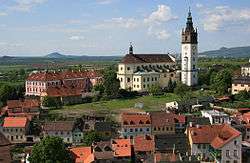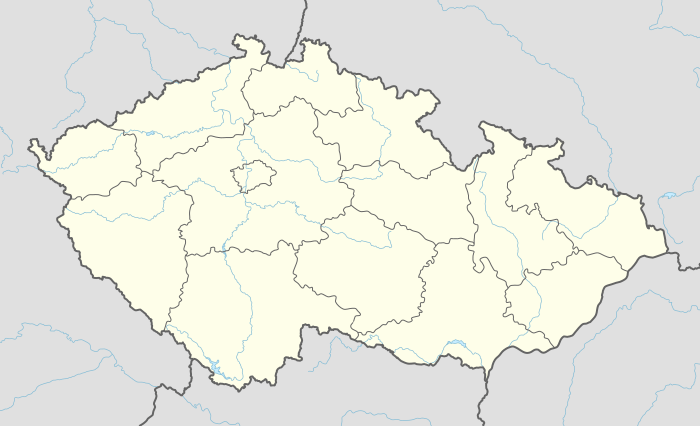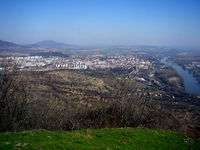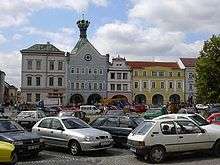Litoměřice
Litoměřice (Czech pronunciation: [ˈlɪtomɲɛr̝ɪtsɛ]; German: Leitmeritz) is a town at the junction of the rivers Elbe (Czech: Labe) and Ohře (German: Eger) in the northern part of the Czech Republic, approximately 64 km (40 mi) northwest of Prague.
Litoměřice | |
|---|---|
Town | |
 Cathedral of St. Stephen with belfry. | |
 Flag  Coat of arms | |
 Litoměřice Location in the Czech Republic | |
| Coordinates: 50°32′3″N 14°7′58″E | |
| Country | Czech Republic |
| Region | Ústí nad Labem |
| District | Litoměřice |
| Founded around | 10th century |
| Royal status | 1219 |
| Government | |
| • Mayor | Ladislav Chlupáč (ODS) |
| Area | |
| • Total | 17.99 km2 (6.95 sq mi) |
| Elevation | 136 m (446 ft) |
| Population (2019-01-01[1]) | |
| • Total | 24,001 |
| • Density | 1,300/km2 (3,500/sq mi) |
| Time zone | UTC+1 (CET) |
| • Summer (DST) | UTC+2 (CEST) |
| Postal code | 412 01 |
| Website | www.litomerice.cz |
The area within the Ústí nad Labem Region is sometimes called The Garden of Bohemia due to the mild weather conditions important for growing fruits and grapes. During the time of the Austro-Hungarian Empire, many pensioners chose it over more southern areas of the Empire.
The town is also the seat of the Roman Catholic Diocese of Litoměřice (part of Archdiocese of Prague), the 4th oldest – and 3rd still existing – Catholic diocese on present Czech territory.
History
The settlement of Litoměřice has a deep history of Paleolithic cultures as well as large Celtic settlements of the La Tène culture, which did not survive the incoming Germanic attacks. The area was later settled by Germanic tribes, when Litoměřice first appear on Ptolemy's Map in the 2nd Century under the name of Nomisterium. The Germanic tribes later migrated west and those remaining mingled with the incoming Slavs.

One of the oldest Czech towns, Litoměřice was established in the 10th century on the site of an early medieval Přemyslid Dynasty fort. The area was settled by the Czech tribe of Litoměřici, after which the town was named. In the High Middle Ages a small group of German settlers was also invited in by Slavic rulers. A royal-town statute was granted in 1219 by the Czech king, Přemysl Otakar I.. From the 12th to the 17th century it was a significant trading centre in the Holy Roman Empire.
The population suffered during the 15th century Hussite Wars. After the Protestant tensions with the Catholics that triggered the Thirty Years' War and the Protestants' defeat in the Battle of White Mountain, the surviving population of the city was forced to accept Catholicism or face property confiscation and the obligation to leave the kingdom. In this way, the town became a Catholic bishop's residency in 1655. As a result, the Czech Protestant population shrank and the town became largely Germanized.

In 1918, Bohemia, Moravia and Czech Silesia became constituent parts of the newly-created Czechoslovakia (which was confirmed by the Treaty of St. Germain), along with a large border area inhabited predominantly by Germans. Local Germans tried to join German Austria (which in turn aimed to join post-war German Reich), but Czechoslovak troops prevented this. Known under the informal name of the Sudetenland, the region became the subject of political controversy in the following years. Slavs settled there again, but remained a minority. In 1938, after the Munich Agreement, German troops occupied the Sudetenland (and all the rest of Czech lands a few months later). The Czech population, which had grown to about 5,000 people, had to leave again.
Jews from Leitmeritz were forced to flee to the Protectorate or were deported during the Holocaust in the Sudetenland.[2] From March 1944 to May 1945, Leitmeritz concentration camp was located west of the town. 18,000 prisoners passed through the camp and were forced to work mostly on excavating underground factories (Richard I and II) under Radobýl. 4,500 died.[3][4]
In the final stages of World War II, German troops retreated to escape the advancing Red Army. The Czech resistance took control of the castle on 27 April 1945, and after a few days they started negotiations with the German commander about the terms of his surrender. The Wehrmacht capitulated in the night after 8 May, but German troops fled on 9 May, just before Soviet troops entered the town on 10 May 1945. Most of the German population of the town was expelled by the so-called Beneš decrees in August 1945, along with about 2.5 million other former Czechoslovak citizens of German ethnicity from the country.
Sights

There are several main sights already visible when approaching Litoměřice. The Baroque St. Stephen's Cathedral at the Cathedral Square (Dómské náměstí) was built in place of an older Romanasque basilica in the years 1664–1668. The interior is almost completely authentic with main and six side altars and a lot of original paintings. Right next to the dome is a bishop's residence built in 1683–1701 by Giulio Broggio. On the main square there is All-Saints Church and within distance there is an Annunciation (Lady Day) Church, another masterpiece built by the son of Giulio Broggio, Octavio. The old town hall (now city museum) and Black Eagle House (Dům u černého orla) on the main square are also worthy a look. The symbol of the city is a chalice, since the watchout tower on the Town Hall has this shape.
There are numerous cellars connected by an extensive web of underground ways under the town. In some places, the cellars were built in three floors. The ways are about three kilometers (1.9 miles) long and they belong to the longest of their kind in the Czech Republic. Unfortunately, only 336 metres (1,102 feet) of these underground ways are open to the public. You can notice the ancient town wall when entering the town. The original town wall was built in the Gothic style. Northern Bohemian Gallery of Creative Arts (SGVU) is based close the main square. Extensive collection spans from 13th century to contemporary art with numerous other exhibitions during the year.
Population
- 1 December 1930 : 18,498 (10,878 Germans, 6,485 Czechs, 143 Jews[5])
- 17 May 1939: 17,267
- 22 May 1947: 14,402
- 2 June 2004: 25,517
- 31 December 2012: 24,316
- 1 January 2015: 24,101
- 1 January 2019: 24,001
Notable residents
- Rudolf Buchbinder (born 1946), Austrian classical pianist
- Ferdinand Blumentritt, teacher, historian, ethnologist and close friend of the Philippine national hero José Rizal, lived and taught here 1877–1913.
- Vincent Bochdalek (1801 - 1883), anatomist and pathologist
- Josef Emanuel Hilscher (1806–1837), Austrian soldier, poet and translator
- Josef Jungmann, creator of the modern Czech language, lived and taught here from 1799 to 1815.
- Alfred Kubin, Austrian expressionist and illustrator was born in Litoměřice in 1877.
- Peter Lerche (born 1928), German jurist
- Prof. Friedrich (Fritz) Novotny (1929-2018), architect
- Karel Hynek Mácha, died in Litoměřice, shortly after he had moved to the town, and was buried there. Later his grave was moved to Prague where he is buried now at the Vyšehrad cemetery.
- Dietrich Mattausch (born 1940), German actor
- Johann Georg Reißmüller (1932–2018), German journalist
- Antonio Rosetti, famed classical composer was born in Litomerice.
- Cardinal Graf von Schönborn, current Archbishop of Vienna, was born near the town.
- Štěpán Cardinal Trochta was Bishop of Litoměřice from 1947.
- The Master of the Litoměřice Altarpiece received his name from this town.
There are several successful sportsmen who were born, lived or are living in Litoměřice, among other olympic medalists, world champions or Stanley Cup winners:
- Oldřiška Marešová Olympic high jumper
- Květa Jeriová-Pecková, triple olympic medalist, Cross-country skiing
- Zdeněk Pecka, double olympic medalist, quadruple and double sculls crew member
- Martin Škoula, a professional ice hockey player currently playing for the Avangard Omsk of the Kontinental Hockey League.
- Milan Hnilička, former professional ice hockey goaltender, triple olympic medalist and septuple IIHF World Championship medalist was born in Litoměřice in 1973.
International relations
Twin towns — Sister cities
Litoměřice is twinned with:





References
- "Population of municipalities of the Czech republic". Czech Statistical Office. Retrieved 2019-04-30.
- Osterloh, Jörg (2015). "Sudetenland". In Gruner, Wolf; Osterloh, Jörg (eds.). The Greater German Reich and the Jews: Nazi Persecution Policies in the Annexed Territories 1935–1945. War and Genocide. Translated by Heise, Bernard. New York: Berghahn Books. pp. 68–98. ISBN 978-1-78238-444-1.CS1 maint: ref=harv (link)
- Le Blond, Josie (26 May 2014). "Slave probe exposes Audi's Nazi past". The Local. Retrieved 9 January 2020.
- Skriebeleit, Jörg (2007). "Leitmeritz". In Benz, Wolfgang; Distel, Barbara (eds.). Flossenbürg: das Konzentrationslager Flossenbürg und seine Außenlager [Flossenbürg: Flossenbürg Concentration Camp and its Subcamps] (in German). Munich: C. H. Beck. pp. 169–175. ISBN 9783406562297.CS1 maint: ref=harv (link)
- Michael Rademacher (dissertation): Deutsche Verwaltungsgeschichte von der Reichseinigung 1871 bis zur Wiedervereinigung 1990. Landkreis Leitmeritz, Osnabrück, 2006.
External links
| Wikisource has the text of the Encyclopaedia Britannica (9th ed.) article Leitmeritz. |
| Wikivoyage has a travel guide for Litoměřice. |
| Wikimedia Commons has media related to Litoměřice. |
- Litoměřice at the official website of the Czech Republic www.czech.cz
- Official website (in Czech)
- Official website (in German)
- Official website (in English)
- Crystal Touch Museum